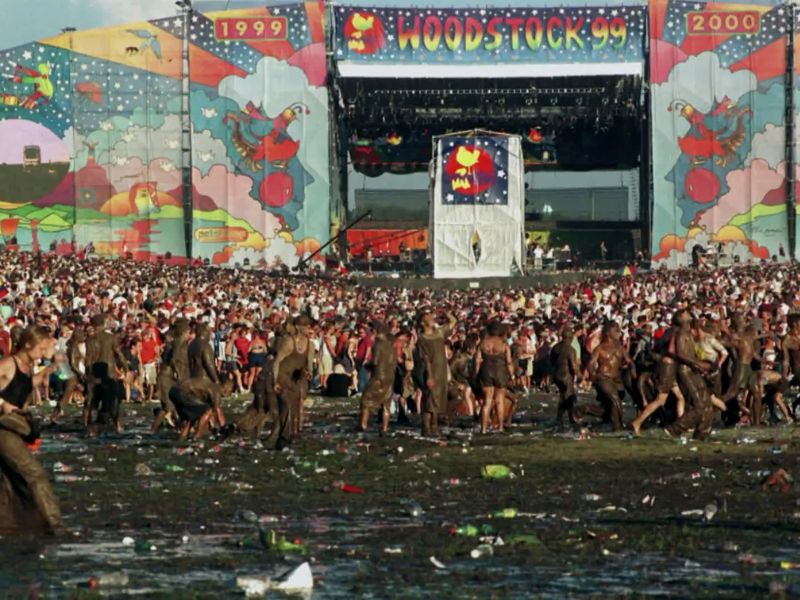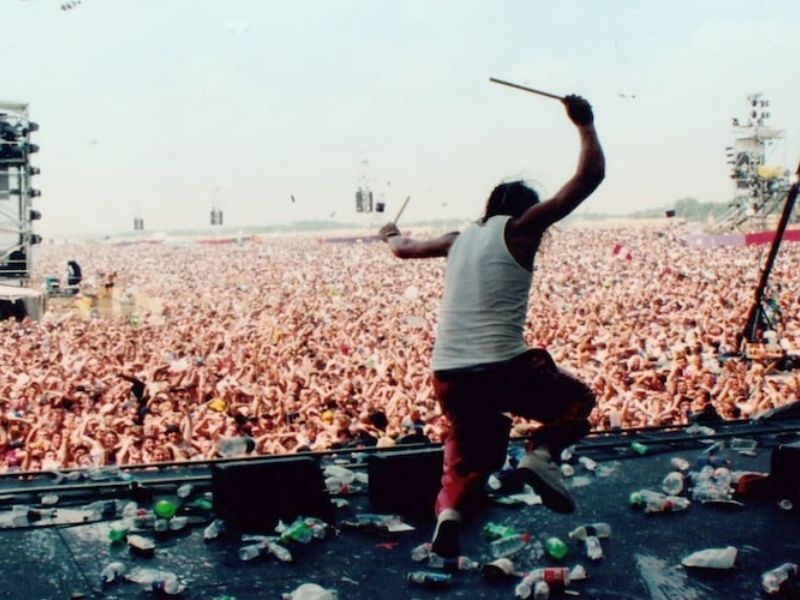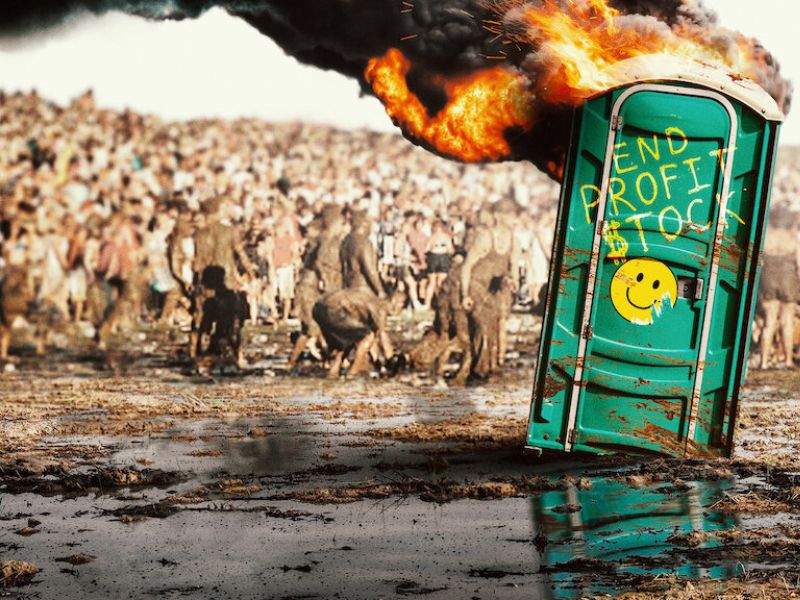Dok.cetera: Woodstock ‘99 – Lost in the Present
When those who’ve only primarily known the 21st century come across the term “Woodstock”, many will recall the tie-dyed camaraderie of the famed 1969 peace, love, and music celebration. That event, held on sprawling upstate New York farmland amidst the throws of the Vietnam War, was the ultimate stop during the “Summer of Love”. A coming together of art and activism for some quarter million attendees and featuring a who’s who of the era’s best musical acts and poets, Woodstock was a singular moment in the history of America with music and the generation of idealists who – at least for that moment – believed in a world beyond war and profit; its grainy imagery, analogue amplifications, and muddy confines have been embedded within the public’s consciousness of 1960s counterculture since the first moments its gates flung open. As expertly captured in Michael Wadleigh’s eponymous 1970 documentary, Woodstock was indeed a generation-defining event and one that now occupies a space closer to idealism than its own reality.

A generation defined
In the age of social media everything, the notion of the “generation-defining” event has lost much of its lustre. On a virtually daily basis, we hear such terms, often capturing a minuscule sentiment of the moment but hardly the longevity of influence. But the power of the label is not lost on industry, where such adjectives riddle publicity campaigns and internet virality with little more than blind claims and the whim of a fear-of-missing-out readership to incessantly catch them. However, at the turn of the century, such contemporary dynamics were in their infancy. Social media was, though existent, rudimentary and large-large-scale cultural events such as Woodstock were few and far between (a far cry from today’s massive music festival industry). With such conditions, predicting an event of consequence was difficult, but when you did, you didn’t just know it; you felt it. And such was the case for the infamous 30th-anniversary edition of the beloved 1969 event: Woodstock 99. The polar opposite of everything positively embedding the former into history’s collective memory, Woodstock’s chaotic 1999 version was also, in its own way, a generation-defining event, albeit one of far less public admiration. Nevertheless, it may have very well laid the template of current festival practice while providing an early look into the angst brought on by the blatant profiteering of late-stage cultural capitalism.
As we come up on the 25th anniversary of Woodstock 99, two documentaries are currently available to stream that covers the festival with differing levels of intention and analysis. The first is HBO Max’s Woodstock 99: Peace, Love and Rage – part of its Music Box series of music-related documentaries. The second and most recent is Netflix’s v – a far more compressive and balanced multi-part mini-series. Both are similar in their talking-head-driven construction and feature several artists, attendees and those peripherally involved with the event giving a broadly chronological overview of its planning, presentation, and aftermath. However, as someone in attendance, both combined only paint the beginnings of the reality on the ground and mainly assume a collective approach to the behavior and intentions of its participants.
Aside from the original’s anniversary, Woodstock 99 doubled also as an awareness-raiser on gun violence in America (in an era when the country’s propensity for mass shootings was significantly less; the Columbine, Colorado high school massacre of the prior year occurred well outside the redundancy and current complacency that occupies today’s citizenry’s collective conscious on the matter). In 1994, there was also a relatively tame Woodstock edition and – as Netflix’s mini-series points out – operated at a significant financial loss. But, in 1999, the festival’s original organiser Michael Lang and producer/promoter John Scher were determined to throw the biggest music festival of its time while making a healthy profit. The specifics of how they did this exactly are presented well enough across both documentaries – although Netflix’s day-to-day breakdown presentation offers a far more detailed insight, the main takeaways are twofold: corporate sponsorship and cutting corners (and costs) wherever possible. The first of these is obvious as to what it entails – price gauging, class separations, and the beginnings of an “experience” culture where cost directly equates to prestige.
The second, however, is always specific to the event at hand. In terms of Woodstock 99, as the documentaries show (and my own experience can attest), this included the hiring of non-professional security (as Lang mentions in Trainwreck, “We didn’t want government agents on the premises”), minimal vital resources (food, water, etc. – corporate-sponsored by the likes of Coca Cola et al., and given free rein to set adaptive “market based” prices allowed to adapt to the conditions on the ground) and the lack of maintenance of facilities (clean toilets, for example, resulting in a bacterial overflow into the drinking supply). Add into the fray that the event was moved from the lush greenery of 1969’s Max Yasgur’s Farm to the sprawling concrete of a still-in-use military base while its three days occurred in blistering 45+ degree heat. A recipe for disaster was on the wall. Oh… and the lineup… a far cry from the Jimi Hendrik, Janis Joplin, Grateful Dead era of 1969. For 1999, headlining acts included the likes of Chemical Brothers, The Offspring, Metallica, Kid Rock, Rage Against the Machine, Red Hot Chilli Peppers, and many more (three women were on the bill across all days – Alanis Morissette, Sheryl Crow, and Jewel). What resulted was a Lord of the Flies-type atmosphere – riots, assaults, looting, mass fires and destruction, leaving the entirety of the sprawling airfield aflame and an ultimate clash between concertgoers and the National Guard ending the affair.

Presentism
Needless to say, the two documentaries and virtually all media coverage since the event occurred have been focused on its outcome. Even a quarter century later, we rarely see such an outpouring of aggression at such festivals. There was the incompetence and greed of the Fyre Festival a couple of years back (also the subject of duelling documentaries Hulu’s Fyre Fraud and Netflix’ Fyre Festival: The Greatest Party That Never Happened), or there was the August 2022 violence and arson at the UK’s Reading Festival or the multiple shootings of Miami’s 2019 Rolling Loud festival. Still, nothing comes close to the pent-up angst of Woodstock 99. How each documentary addresses this is the telling factor of their ultimate effect. In Trainwreck, its presentation draws from an earlier music documentary mini-series of sprawl, Jeen-Yuhs: A Kanye Trilogy. Though that series of episodes cover literal decades, the respective three days/three-episode breakdown of Netflix is none less action-packed. By contrast, Woodstock ‘99: Peace, Love, and Rage, and its minimal 60+ minutes run time, seems far more concerned with Presentism than the multi-layered socio-cultural analysis required of such a generation-defining event. For HBO Max and much of contemporary media response to the event’s cultural resurgence, “blame” ultimately falls on those in attendance. Featuring such titles as Woodstock ‘99 and the Rise of Toxic Masculinity, Woodstock ’99 doc carefully traces back the roots of white, male rage, or HBO’s Woodstock ’99 Documentary Is a Harrowing Look at the Anger and Entitlement of Young White Men, for them, Woodstock ‘99 was a gathering of white male rage, lacking in self-evaluation and perpetuated by aggressive music. For Netflix, however, the argument is far less superficial. Aided by its multi-part presentation, Trainwreck considers all aspects of the festival, from its planning to its evolving ethos to its physical production to the weather, prices, music, location, and more. Though veering into its own version of presentism, Netflix (rightly) focuses its gaze more on the sociopathic nature of Lang and Sher.
But where both documentaries fall disappointingly short is on the subject of sexual assault. In both, the topic of the multiple reported rapes, as well as the near-constant groping, were relegated to some five minutes of airtime without ever hearing from survivors; instead, the time was given to Lang and Sher’s disgusting victim blaming. To its credit, though, part two of Trainwreck makes mentions perhaps the most well-known of these stories, where a heavily intoxicated group of men stole a truck, drove it into the airplane hangar rave during the Fatboy Slim performance, later authorities finding a nearly naked, unconscious woman in the back. As the head of the airplane hanger venue noted, this was the moment where, for many involved, the realities of the event came into full view, changing the atmosphere officially from hedonism to concern.
Several other important contextual aspects of the festival and performances also did not make it into one, or either, of the documentaries. Most likely due to licensing issues, some instances of consequence could have aided the overall argument toward the festival’s outcome. For example, missing was the Rage Against the Machine day-two performance sandwiched between Limp Bizkit and Metallica, ending with the American flag being set on fire. Also missing was that, though confiscating food and water, front entrance security allowed virtually all drugs and alcohol into the premises. Furthermore, the intensity of the heat and price gauging on site were not done justice, albeit with a higher focus in Trainwreck. As mentioned, vendors were subject to market forces, so when there wasn’t enough water or food by the second half of day two, prices could adjust accordingly based on demand. This meant a 3 USD bottle of water (already relatively high for the time) could quickly turn into 12 – 14 USD. Also, the sheer diversity of the crowd was never dwelled upon, with both documentaries glossing over the multitude of demographics represented across its participants. Instead, the focus was almost entirely on the shirtless, backwards hat-wearing twenty-something white male who, although in high numbers, hardly represented the plurality of the crowd. Finally, the general hedonism, anything-goes-atmosphere of the entire festival could never be done proper justice without turning into an XXX-rated exploitation film – rampant drug use of all kinds, group sex throughout, and levels of bi-gendered nudity as far as the eye could see. No matter how much each documentary tried to effectively depict this, neither could – although the on-site Pay Per View cameras focused almost entirely on this aspect of the festival, so comprehensive such footage does exist.

In the end…
By the time day three progressed to its conclusions, and the Red Hot Chilli Peppers took to the stage, Woodstock ‘99 was as combustible a pot as possible. The tone-deaf nature of its organizers continued with their planned gun violence vigil, handing out candles to the nearly quarter million in attendance, as the band arrogantly kicked onto a cover version of the Jimi Hendrix classic ‘Fire’. From there, one bonfire turned to two, and two turned to several. Speaker towers were torn down, as were the perimeter wall (what was left of it as this had begun during day two). The now inflamed airfield lay the stage for a “Fuck you, I won’t do what you tell me” chanting mob who turned their attentions on looting vendors and destroying what remained of the space. Tired of the heat, costs, filth, and, yes, amped up by intensely energetic and infamous performances from the likes of Korn (to this day, the most enthralling, heavy concert I have witnessed – the late Bronx rapper DMX a close second from the festival) and Limp Bizkit (aside from men, Woodstock ‘99: Peace, and Love and Rage, also puts heavy criticism of frontman Fred Durst’s onstage antics, panic early during the breakdown of notorious Nu-Metal anthem ‘Break Stuff’ where he adamantly taunts a visibly aggressive crowd to “reach deep down inside and take all that negative energy … and let that shit out of your fuckin’ system… when this song kicks in, I want you to fuckin’ kick in!”), this point signalled the definitive end of Woodstock 99.
For me, perhaps aided by a bit of teenage naivete, Woodstock ’99 may have been the seminal cultural experience of my life and one whose dynamics I see everywhere – with the festival world largely having learned nothing from the event. Today, festivals are routinely overcrowded, costs have become laughable, (non-VIP) facilities are often neglected, and lineups… well, I think it’s safe to say that music has become as aggressive, misogynistic, and hateful as ever. In this way, Woodstock ’99s lasting legacy holds far beyond the convenient presentist reading of an event far more diverse than credited. It is easy to place blame on those consuming and the contemporized definitions of doing so properly, but it is far more difficult to objectively place an event within its time, place, and era, especially one which essentially served as a microcosm of the frustrations and angst people across demographic feel some quarter century on. In this way, Woodstock 99 was generation-defining in its prophetic reading of the industry to come.
"Came to Bucharest after living in Amsterdam & Brooklyn, among others, Steve is the industry editor for Modern Times Review documentary magazine.
